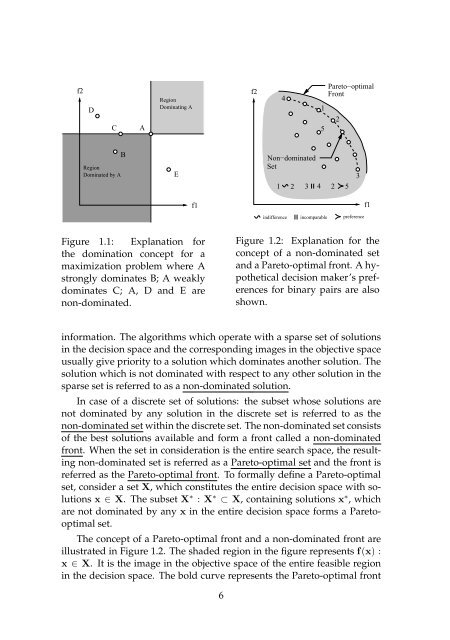Progressively Interactive Evolutionary Multi-Objective Optimization ...
Progressively Interactive Evolutionary Multi-Objective Optimization ...
Progressively Interactive Evolutionary Multi-Objective Optimization ...
You also want an ePaper? Increase the reach of your titles
YUMPU automatically turns print PDFs into web optimized ePapers that Google loves.
f2<br />
D<br />
C<br />
Region<br />
Dominated by A<br />
B<br />
A<br />
Region<br />
Dominating A<br />
Figure 1.1: Explanation for<br />
the domination concept for a<br />
maximization problem where A<br />
strongly dominates B; A weakly<br />
dominates C; A, D and E are<br />
non-dominated.<br />
E<br />
f1<br />
f2<br />
4<br />
Non−dominated<br />
Set<br />
1 2 3 4 2 5<br />
Pareto−optimal<br />
Front<br />
indifference incomparable preference<br />
Figure 1.2: Explanation for the<br />
concept of a non-dominated set<br />
and a Pareto-optimal front. A hypothetical<br />
decision maker’s preferences<br />
for binary pairs are also<br />
shown.<br />
information. The algorithms which operate with a sparse set of solutions<br />
in the decision space and the corresponding images in the objective space<br />
usually give priority to a solution which dominates another solution. The<br />
solution which is not dominated with respect to any other solution in the<br />
sparse set is referred to as a non-dominated solution.<br />
In case of a discrete set of solutions: the subset whose solutions are<br />
not dominated by any solution in the discrete set is referred to as the<br />
non-dominated set within the discrete set. The non-dominated set consists<br />
of the best solutions available and form a front called a non-dominated<br />
front. When the set in consideration is the entire search space, the resulting<br />
non-dominated set is referred as a Pareto-optimal set and the front is<br />
referred as the Pareto-optimal front. To formally define a Pareto-optimal<br />
set, consider a set X, which constitutes the entire decision space with solutions<br />
x ∈ X. The subset X ∗ : X ∗ ⊂ X, containing solutions x ∗ , which<br />
are not dominated by any x in the entire decision space forms a Paretooptimal<br />
set.<br />
The concept of a Pareto-optimal front and a non-dominated front are<br />
illustrated in Figure 1.2. The shaded region in the figure represents f(x) :<br />
x ∈ X. It is the image in the objective space of the entire feasible region<br />
in the decision space. The bold curve represents the Pareto-optimal front<br />
6<br />
1<br />
5<br />
2<br />
3<br />
f1
















